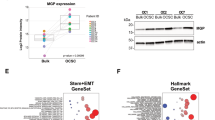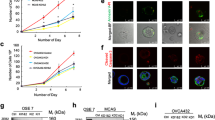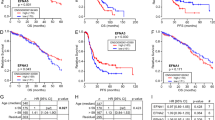Abstract
Since autocrine regulation of HGF-Met is implicated in many forms of human cancer, we investigated whether the predisposition to develop ovarian cancer in women with hereditary ovarian cancer syndromes involves changes in the expression of HGF-Met by the tissue of origin of epithelial ovarian cancers, the ovarian surface epithelium (OSE). We compared cultures of normal OSE from women with (FH-OSE) (n=20) and with no (NFH-OSE) (n=48) family histories of ovarian cancer, SV40 Tag immortalized OSE lines (IOSE, n=5) and ovarian cancer cell lines (n=3). Cultures derived from 21/22 women with NFH-OSE and 13/13 women with FH-OSE expressed Met mRNA initially. After two to three passages, Met was downregulated in 37% of NFH-OSE cultures but persisted in 100% of FH-OSE cultures and ovarian cancer lines, like other epithelial differentiation markers that are stabilized in FH-OSE and neoplasia. HGF and Met mRNA were concomitantly expressed by NFH-OSE from only three of 32 women but in FH-OSE from eight of 13 women, and also in five of five IOSE and two of three ovarian cancer lines. Conditioned media from FH-OSE, but not NFH-OSE, contained immunoreactive HGF and induced cohort migration which was inhibited by neutralizing HGF antibody. Several signaling molecules of the PI3K pathway, including Akt2 and p70 S6K, were constitutively activated in FH-OSE from six of six women but in NFH-OSE from only four of eight women. Exogenous HGF was mitogenic in OSE, and that effect was regulated through the MAP kinase (ERK1/ERK2) and FRAP/p70 S6K pathways. The proliferative response to HGF was greater in NFH-OSE than in FH-OSE cultures. The results show that FH-OSE cultures differ from NFH-OSE by increased stability of Met expression and by HGF secretion. Constitutive phosphorylation of kinases and a diminished growth response to HGF suggest the presence of autocrine regulation in FH-OSE. In analogy with other cell types where an autocrine HGF-Met loop has been implicated in tumorigenic transformation, this change in FH-OSE may play a role in the enhanced susceptibility to ovarian carcinogenesis in women with hereditary ovarian cancer syndromes.
This is a preview of subscription content, access via your institution
Access options
Subscribe to this journal
Receive 50 print issues and online access
$259.00 per year
only $5.18 per issue
Buy this article
- Purchase on Springer Link
- Instant access to full article PDF
Prices may be subject to local taxes which are calculated during checkout









Similar content being viewed by others
References
Auersperg N, Maines-Bandiera S, Dyck HG, Kruk PA . 1994 Lab. Invest. 71: 510–518
Auersperg N, Maines-Bandiera S, Booth JH, Lynch HT, Godwin AK, Hamilton T . 1995 Am. J. Obstet. Gynecol. 173: 558–565
Auersperg N, Edelson MI, Mok SC, Johnson SW, Hamilton TC . 1998 Sem. Oncol. 25: 281–304
Aunoble B, Sanches R, Didier E, Bignon YJ . 2000 Int. J. Oncol. 16: 567–576
Balkovetz DF . 1999 Life Sci. 64: 1393–1401
Bottaro DP, Robin JS, Chan AM, Kmiecik TE, Vande Woude GF, Aaronson SA . 1991 Science 251: 802–804
Brinkmann V, Foroutan H, Sachs M, Weidner KM, Birchmeier W . 1995 J. Cell Biol. 131: 1573–1586
Corps AN, Sowter HM, Smith SK . 1997 Int. J. Cancer 73: 151–155
Di Renzo MF, Narsimhan RP, Olivero M, Bretti S, Giordano S, Medico E, Gaglia P, Zara P, Comoglio PM . 1991 Oncogene 6: 1997–2003
Di Renzo MF, Olivero M, Katsaros D, Crepald T, Gaglia P, Zola P, Sismondi P, Comoglio PM . 1994 Int. J. Cancer 58: 658–662
Dyck HG, Hamilton TC, Godwin AK, Lynch HT, Maines-Bandiera SL, Auersperg N . 1996 Int. J. Cancer 69: 429–436
Elliott WM, Auersperg N . 1993 Biotech. Histochem. 68: 29–35
Gulati R, Peluso JJ . 1997 Endocrinol. 138: 1847–1856
Hess S, Gulati R, Peluso JJ . 1999 Endocrinol. 140: 2908–2916
Hulleman E, Bijvelt JJ, Verkleij AJ, Verrips CT, Boonstra J . 1999 J. Cell Physiol. 180: 325–333
Huntsman D, Resau JH, Klineberg E, Auersperg N . 1999 Am. J. Pathol. 155: 343–348
Jiang W, Hiscox S, Matsumoto K, Nakamura T . 1999 Crit. Rev. Oncol. Hematol. 29: 209–248
Khwaja A, Rodriguez-Viciana P, Wennstrom S, Warne PH, Downward J . 1997 EMBO J. 16: 2783–2793
Kim SO, Hasham MI, Katz S, Pelech SL . 1998 J. Cell. Biochem. 71: 328–339
Klominek J, Baskin B, Liu Z, Hauzenberger D . 1998 Int. J. Cancer 76: 240–249
Kruk PA, Uitto VJ, Firth JD, Dedhar S, Auersperg N . 1994 Exp. Cell Res. 215: 97–108
Maines-Bandiera SL, Kruk PA, Auersperg N . 1992 Am. J. Obstet. Gynecol. 167: 729–735
Miyazawa K, Shimomura T, Kitamura N . 1996 J. Biol. Chem. 271: 3615–3618
Moghul A, Lin L, Beedle A, Kanbour-Shakir A, DeFrances MC, Liu Y, Zarnegar R . 1994 Oncogene 9: 2045–2052
Montesano R, Matsumoto K, Nakamura T, Orci L . 1991 Cell 67: 901–908
Nabeshima K, Shimao Y, Inoue T, Itoh T, Kataoka H, Koono M . 1998 Int. J. Cancer 78: 750–759
Ong A, Maines-Bandiera SL, Roskelley CD, Auersperg N . 2000 Int. J. Cancer 85: 430–437
Parrott JA, Vigne J-L, Chu BZ, Skinner MK . 1994 Endocrinol. 135: 569–575
Parrott JA, Skinner MK . 2000 Biol. Reprod. 62: 491–500
Parrott LA, Templeton DJ . 1999 J. Biol. Chem. 274: 24731–24736
Pece S, Chiariell O, Murga L, Gutkind JS . 1999 J. Biol. Chem. 274: 19347–19351
Sato N, Takahashi H . 1997 Respirol. 3: 185–191
Scully RE . 1995 J. Cell. Biochem. 23: 208–218
Shayesteh L, Lu Y, Kuo W-L, Baldocchi R, Godfrey T, Collins C, Pinkel D, Powell B, Mills GB, Gray JW . 1999 Nat. Genet. 21: 99–102
Sonnenberg E, Meyer D, Weidner M, Birchmeier C . 1993 J. Cell Biol. 123: 223–235
Sowter HM, Corps AN, Smith SK . 1999 Int. J. Cancer 83: 476–480
Stoker M, Perryman M . 1985 J. Cell Sci. 77: 209–223
To CTT, Tsao MS . 1998 Oncol. Rep. 5: 1013–1024
Tsarfaty I, Resau JH, Rulong S, Keydar I, Faletto DL, Vande Woude GF . 1992 Science 257: 1258–1261
Tsarfaty I, Rong S, Resau JH, Rulong S, da Silva PP, Vande Woude GF . 1994 Science 263: 98–101
Vande Woude GF, Jeffers M, Cortner J, Alvord G, Tsarfaty I, Resau J . 1997 Ciba Found. Symp. 212: 119–130
Wong AST, Maines-Bandiera SL, Rosen B, Wheelock MJ, Johnson KR, Leung PCK, Auersperg N . 1999 Int. J. Cancer 81: 180–188
Wong AST, Leung PCK, Auersperg N . 2000 Gynecol. Oncol. 78: 158–165
Ziltener HJ, Maines-Bandiera S, Schrader JW, Auersperg N . 1993 Biol. Reprod. 49: 635–641
Acknowledgements
We thank Drs George F Vande Woude (National Health Institute, Bethesda) and Joanne Emerman (University of British Columbia) for providing the human HGF cDNA plasmid pRS24 and the rat-tail-derived type I collagen stock solution, respectively. We are grateful to members of the Department of Obstetrics and Gynecology, University of British Columbia, and the Department of Medical Genetics, Victoria General Hospital, for providing surgical specimens of ovarian surface epithelium and relevant clinical information, and to Drs TC Hamilton and A Godwin for providing case HO-2775-154. We also thank Dr Sung Kim for expert help in setting up the Western blot analysis of protein kinase detection. This work was supported by a grant from the National Cancer Institute of Canada with funds from the Terry Fox Run to NA, and a University of British Columbia Graduate Fellowship to ASTW.
Author information
Authors and Affiliations
Rights and permissions
About this article
Cite this article
Wong, A., Pelech, S., Woo, M. et al. Coexpression of hepatocyte growth factor-Met: an early step in ovarian carcinogenesis?. Oncogene 20, 1318–1328 (2001). https://doi.org/10.1038/sj.onc.1204253
Received:
Revised:
Accepted:
Issue Date:
DOI: https://doi.org/10.1038/sj.onc.1204253
Keywords
This article is cited by
-
TRAP1 downregulation in human ovarian cancer enhances invasion and epithelial–mesenchymal transition
Cell Death & Disease (2016)
-
The Therapeutic Potential of Targeting the HGF/cMET Axis in Ovarian Cancer
Molecular Diagnosis & Therapy (2016)
-
The Role of the Insulin-like Growth Factor-1 Receptor (IGF-1R), Phosphatase and Tensin Homolog (PTEN), c-Met, and the PI3-Kinase Pathway in Colorectal Cancer
Current Colorectal Cancer Reports (2012)
-
Targeting HSP90 in ovarian cancers with multiple receptor tyrosine kinase coactivation
Molecular Cancer (2011)
-
C-MET as a new therapeutic target for the development of novel anticancer drugs
Clinical and Translational Oncology (2010)



